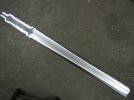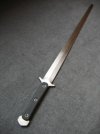- Joined
- Nov 21, 2018
- Messages
- 13
I'm researching steel to make a Tai Chi sword. I recently did a black smith work shop and he suggested looking into nice spring steel or to see what they are made of .
The sword will probably only be used for Tai Chi demonstrion. It likely won't be slicing tatomy mats, but the forged in fire fan in me kind of wants to do a heat treatment.
I don't have a forge of my own so i would be shaping it with either a file or a grinder.
The blade will probably be approximately 3 feet long plus a handle. Does anyone have any recommendations on sizes and steel types?
I thake Tai Chi in Toronto, and there is a Tai Chi sword element in the next level when i grade. I'm sure i can go down to China Town or order something off Amazon, but I want to make my own sword
I want to make something i can be proud of, not use something mass produced.
The sword will probably only be used for Tai Chi demonstrion. It likely won't be slicing tatomy mats, but the forged in fire fan in me kind of wants to do a heat treatment.
I don't have a forge of my own so i would be shaping it with either a file or a grinder.
The blade will probably be approximately 3 feet long plus a handle. Does anyone have any recommendations on sizes and steel types?
I thake Tai Chi in Toronto, and there is a Tai Chi sword element in the next level when i grade. I'm sure i can go down to China Town or order something off Amazon, but I want to make my own sword
I want to make something i can be proud of, not use something mass produced.



